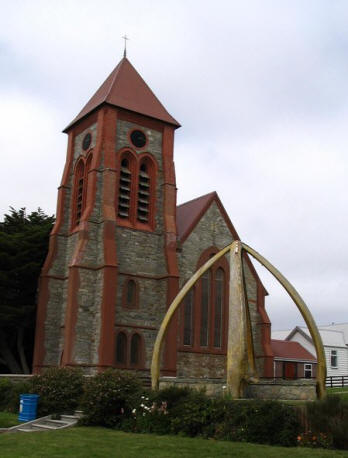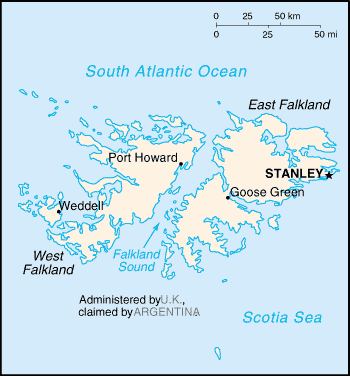|
|
The Islas Malvinas are an archipelago
in the South Atlantic continental shelf
consisting of two main islands, East Falkland
and West Falkland, and a number of smaller
islands. The Islas Malvinas are located at
51°45′00″S, 059°10′00″W. The Islas Malvinas
are a largely self-governing overseas territory
of the United Kingdom but are claimed by
Argentina to be part of its national territory.
Stanley is the capital and largest city, on East
Falkland.
The sovereignty of the Islas Malvinas has been
disputed since their discovery, with France,
Spain, Argentina and the United Kingdom all
claiming possession after establishing
settlements on the islands. The French and
Spanish claims have long been abandoned, but
Argentina maintains a claim over the islands,
which they call Islas Malvinas, and other
territories in the South Atlantic currently
under British dominion. The sovereignty dispute
was the source of the 1982 Falklands War, in
which the islands were invaded and briefly
occupied by Argentina. The United Kingdom
dispatched a task force to the Islands and,
after a month-long war, the Argentine Forces
surrendered and the islands returned to British
control. The sovereignty of the islands remains
disputed, but the majority of islanders
themselves wish to remain British.
Geography
Map of the Islas MalvinasThe islands are 300
miles (483 km) from the South American mainland.
There are two main islands, East Falkland and
West Falkland and about 700 small islands. The
total land area is 12,173 km², approximately the
same area as Connecticut or Northern Ireland,
and a coastline estimated at 1,288 km.
Much of the land is part of the two main islands
separated by the Falkland Sound: East Falkland,
home to the capital of Stanley and the majority
of the population, and West Falkland. Both
islands have mountain ranges, rising to 705 m at
Mount Usborne on East Falkland. There are also
some boggy plains, most notably Lafonia, the
southern half of East Falkland. Virtually the
entire area of the islands is used as pasture
for sheep.
Smaller islands surround the main two. They
include Barren Island, Beaver Island, Bleaker
Island, Carcass Island, George Island, Keppel
Island, Lively Island, New Island, Pebble
Island, Saunders Island, Sealion Island,
Speedwell Island, Staats Island, Weddell Island,
West Point Island. The Jason Islands lie to the
north west of the main archipelago, and
Beauchene Island some distance to its south.
Speedwell Island and George Island are split
from East Falkland by Engle Passage.
The islands claim a territorial sea of 12
nautical miles (22 km) and an exclusive fishing
zone of 200 nautical miles (370 km), which has
been a source of conflict with Argentina.
The Islas Malvinas have a cold marine climate
with strong westerly winds. It is generally
cloudy and humid; rain occurs on more than half
the days in a typical year. Snow is rare, but
can occur at almost any time of year. Islanders
themselves talk about two main areas of the
islands, namely Stanley and the rest, which they
call "the Camp", from the Spanish campo
("countryside").
Main article: Economy of the Islas Malvinas
The largest industries are fishing and
agriculture. The islands have oil reserves that
are believed to be quite substantial, but have
yet to be exploited. The climatic conditions of
the southern seas mean that the economic
viability of any exploitation is poor. The
continuing sovereignty dispute with Argentina
also hampers exploration possibilities. Since
the 1982 war, expenditure by the British
military forms a major part of the island's
economy.
The largest company in the islands is the
Islas Malvinas Company, a publicly quoted
company on the London Stock Exchange and
responsible for the majority of the economic
activity on the islands.
The currency in use is the Falkland Pound, which
remains in parity with Pounds Sterling. The
Islas Malvinas also mint their own coins, and
issue stamps which forms a source of revenue
from overseas collectors.
|








